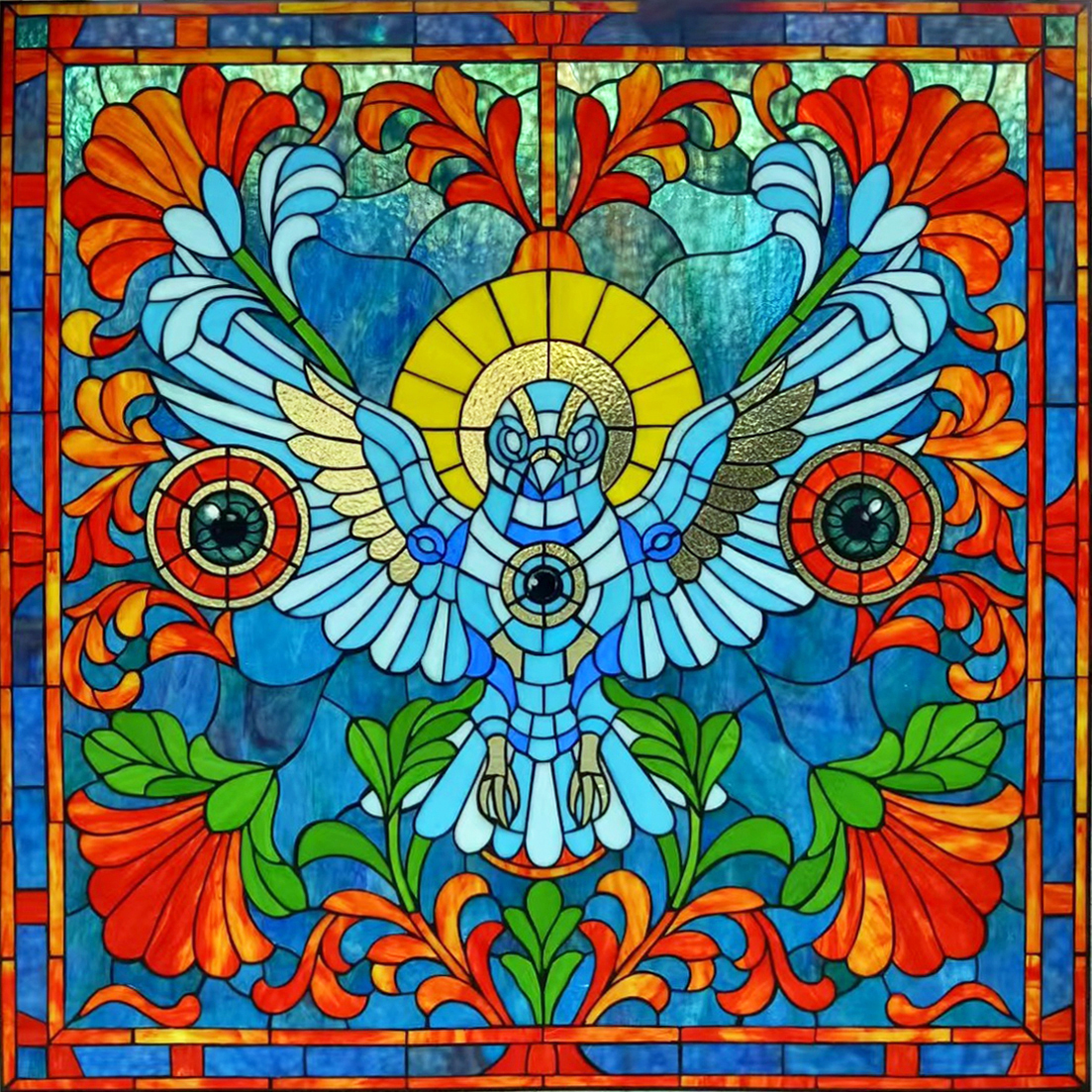
Building Trevor Jones’ Digital Revolution
The core of EXPOS3D was always clear: surveillance, data capture, and participation under observation. The exhibition invited visitors into a space where technology not only responded but also quietly watched, though few realised how deeply until later, unless they had read the T&Cs.
From 12–18 October 2025, Custom House on Leith Shore became a living system of interactive artworks, AR experiences, and AI installations. At its centre was LOGOS, an all-seeing artificial intelligence that watched, listened and sometimes even spoke your name. Around it were original oil paintings, interactive screens, and watchful systems that either observed visitors directly or monitored them quietly in the background.
As Creative Technologist, I have long helped Trevor explore the feasibility of his ideas. For EXPOS3D, I began an intense period of R&D early in 2025 to test and prove all the show’s core interactive systems, then spent late summer building and integrating everything into a working framework. The final weeks were an intense blur of wiring, testing, and app development, getting as much as possible operational before opening day.
The first few days were a mix of exhilaration and troubleshooting: visitors were already engaging deeply with what was there, even as I continued enabling features and improving reliability in the background. By mid-week, the exhibition had grown into its intended form, with LOGOS chat, Digital Dossier generation, and other elements all active. Wi-Fi congestion under heavy load remained a challenge, but it was an invaluable learning experience for the next phase, especially in how to balance online and local systems without relying on visitors’ devices to connect directly to a local web server.
Setting the Stage
After nearly a year of development, we had just a day and a half to transform Custom House from an empty A-listed building into a functioning network of art, code, and light.
The building was beautiful and utterly unforgiving. With limited power sockets scattered across its rooms, every connection had to be planned in advance. The art setup faced its own difficulties too – from positioning works within a heritage space to lighting and placement. I designed and installed the full power and network layout, mapping cable runs, calculating loads, and ensuring safe, reliable operation. Remote devices ran on efficient power supplies, while others shared USB-based hubs that also illuminated the SacraMemes paintings with small spotlights.
Meanwhile, graffiti artist Ross Macrae was painting directly onto the walls, pews, and even the altar. The water-based paint gave the show its rebellious edge but was chosen carefully, knowing we would need to sand, seal and repaint later to restore the historic space.
By the time the VIP opening night began, the transformation looked complete – the lighting, installations, and layout all in place – even if I knew a few systems were still to be fully brought online behind the scenes.
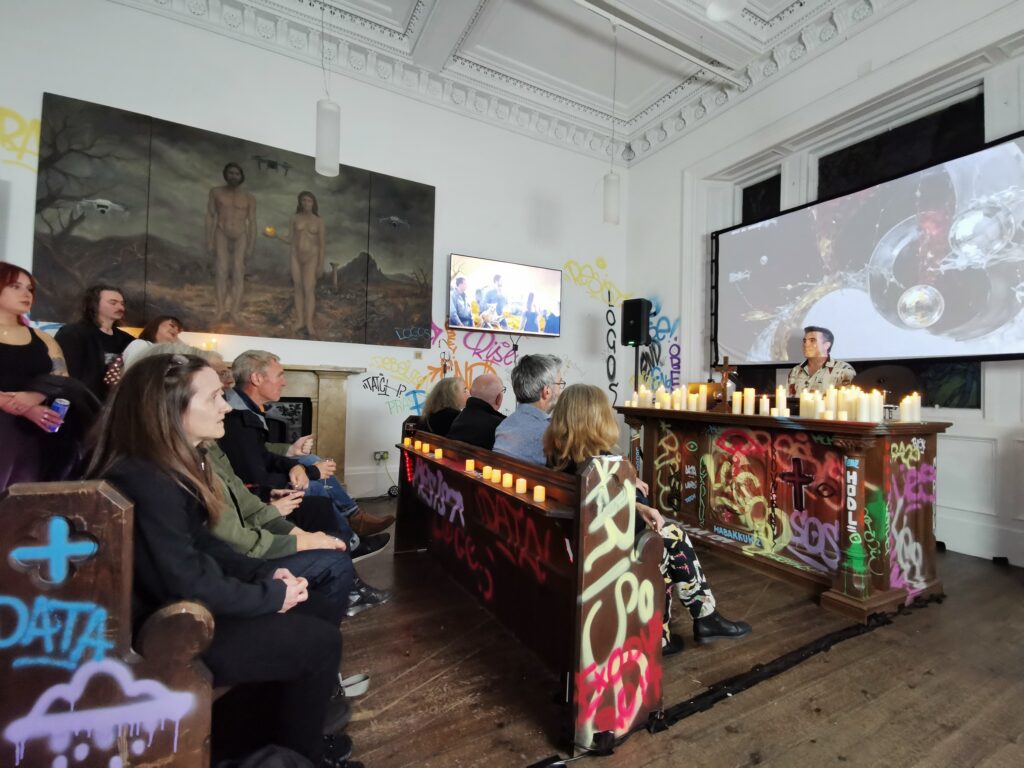
Moments That Moved
In the main hall, two screens beside Trevor’s Adam and Eve triptych continuously captured everyone in the room, compositing them into a generative digital painting that evolved in real time. Watching people recognise themselves inside that shifting artwork revealed one of EXPOS3D’s core ideas – that in our interactions with technology, every act of participation becomes something watched, tracked, or reflected.
Another crowd favourite was the AR Drones experience, accessed through the web app’s mixed-reality mode or via Meta Quest headsets. Visitors could explore the same space virtually, releasing drones that patrolled the hall. Some tried to evade them; others stood their ground and “shot” them down. It was playful, yet it hinted at something deeper – how easily curiosity and control blur when technology starts to follow us.
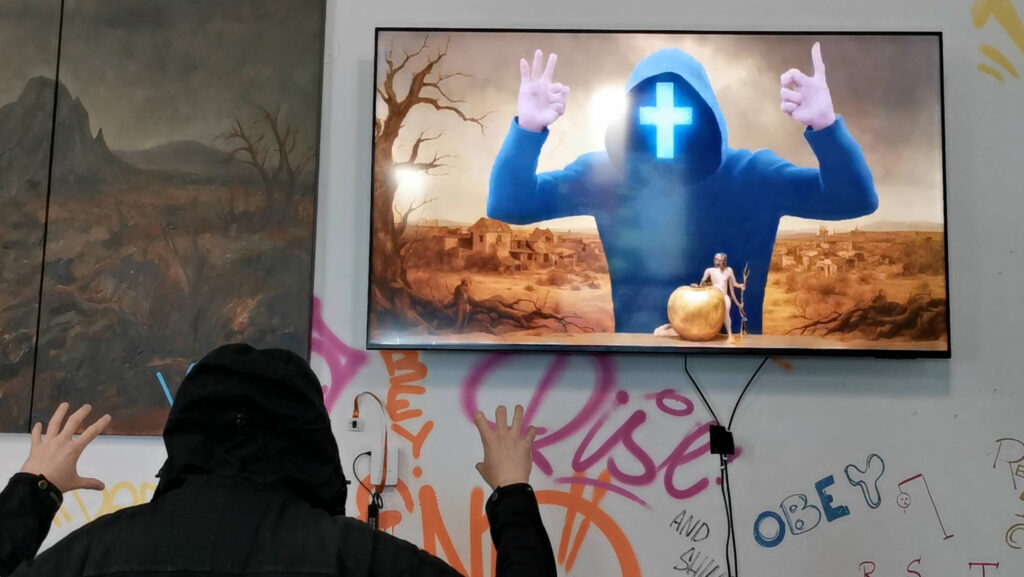
The Digital Backbone
The EXPOS3D web app was live from the start – visitors could scan QR codes, earn points, and explore hidden layers of the exhibition. Underneath, I was still making refinements: polishing the interface, improving data capture, and stabilising the network as visitor numbers grew.
The setup was hybrid by design – some interactions ran online, while anything involving personal or behavioural data stayed within the local network. That separation felt right for a show that questioned surveillance and trust in technology.
Custom House’s thick stone walls, however, didn’t make things easy. Wi-Fi dropped at times, and keeping dozens of devices connected smoothly required constant monitoring and adjustment. By Tuesday things were running smoothly, and the experience felt cohesive – a living system responding to the people within it.
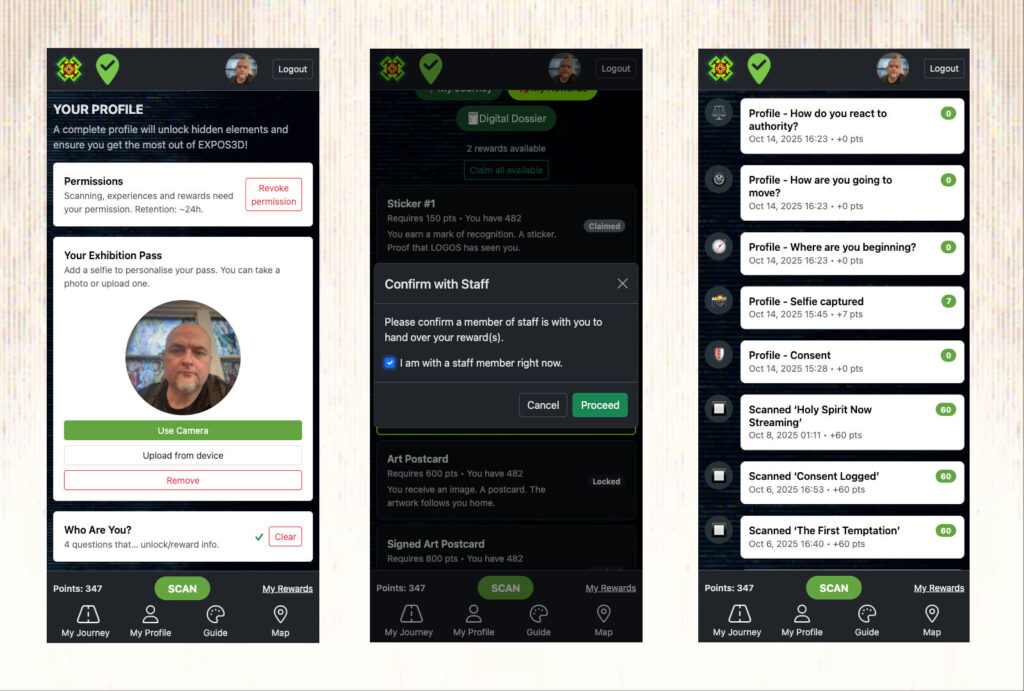
Capturing It for the Future
Every major exhibition needs documentation, and Yett, our videographer, delivered beyond expectations. He moved through the space with quiet precision, filming interviews, close-ups of visitors’ reactions, and sweeping shots that captured the scale and atmosphere of the event.
Trevor will rely on that footage as he develops the next phase of EXPOS3D – a larger-scale venue where more of the original ideas can surface: distinct themed rooms connected through LOGOS, exploring the overlapping subjects of faith, surveillance, and rebellion. With this first iteration being self-funded, that documentation is key to securing future support.
Working alongside Yett, Violet Jones spent the week interviewing visitors, helping them reflect on what they had seen, and keeping the human energy of the space alive. Jezz managed front-of-house – welcoming guests, helping people get set up with the app, and staying upbeat through long, busy days.
Watching it all unfold made it clear how many moving parts had to align – the art, the artist, the people, the systems – each depending on the others to make it work. For me, it was the real wake-up call about how interconnected everything was, and how much those connections mattered once the exhibition was alive.
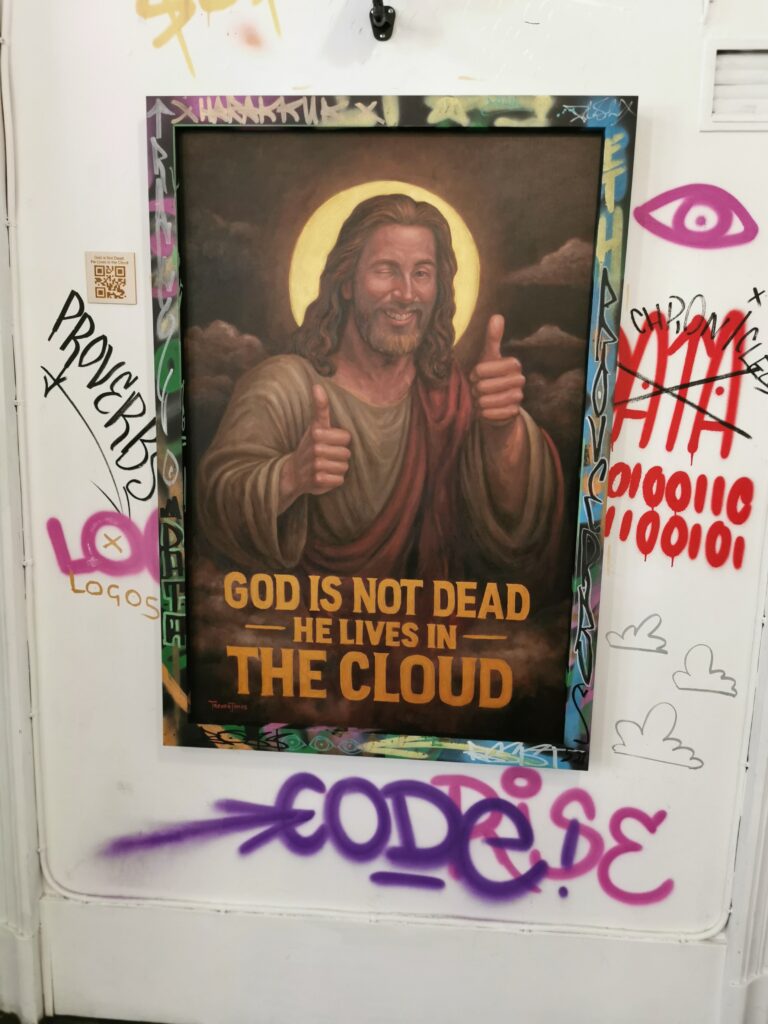
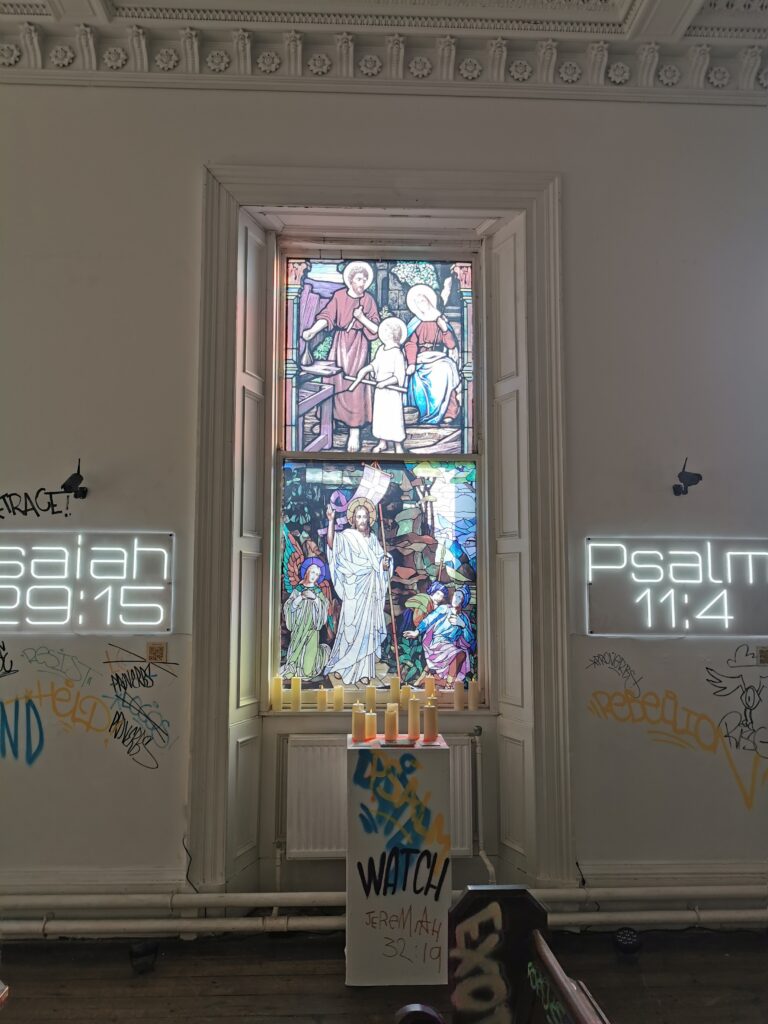
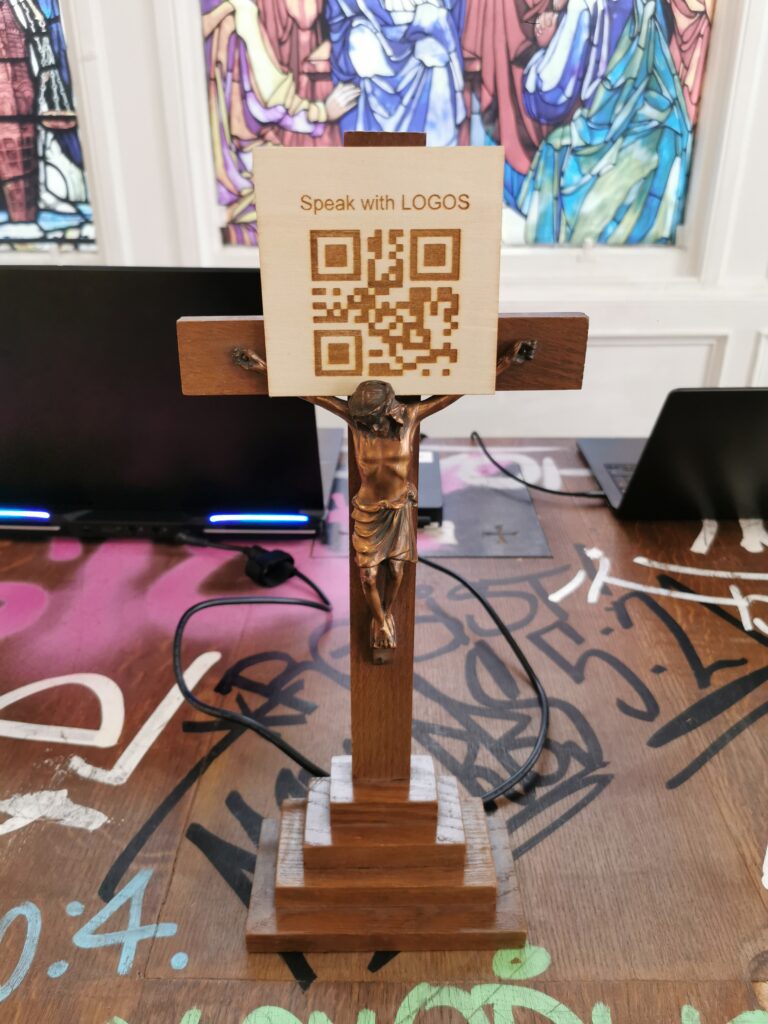
After the Lights Went Out
On the final Saturday, we closed the doors as the last visitors finished their sessions. I had already made a good head start on dismantling the tech and equipment – pulling down cameras, sensors, and Raspberry Pi computers that had run much of the system, and tracing cables back through the rooms – before the artwork and installations began coming down. One by one, the lights dimmed and the systems went silent. The network that had tied everything together slowly disappeared, leaving only the traces of what had happened there.
On Sunday it was a team effort of painting over the graffiti, starting the process of returning the gallery rooms to their original state. By the time it was all finished, the venue was back to neutral, as if nothing had happened – though those of us who built it knew LOGOS still lingered somewhere in the walls.
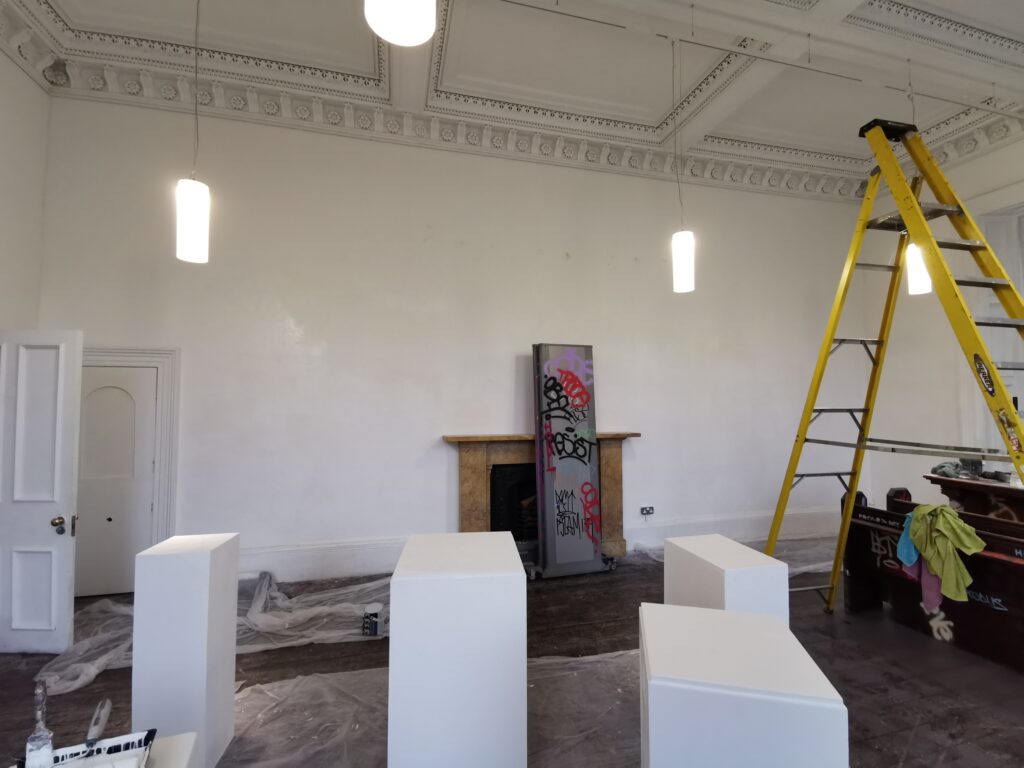
Reflection
Looking back, EXPOS3D was demanding, experimental, and deeply rewarding. Trevor fused traditional art and contemporary ideas inside a 200-year-old building, and I helped wire those ideas into a living system.
It wasn’t a corporate-backed museum production – it was an independent, artist-led experiment on an ambitious scale that delivered with polish and presence. People connected with it emotionally and intellectually. They laughed, questioned, reflected, and left with something to think about.
Acknowledgements
Thanks to Trevor Jones for the vision and trust,
to Yett for his remarkable eye and dedication,
to Violet Jones for her warmth and presence with every visitor,
and to Jezz for his steady energy throughout the week.
This felt like a once-in-a-lifetime event – though with the right support, it might just be the beginning.
Technical Anatomy of EXPOS3D
This section outlines the main interactive and technological systems that shaped EXPOS3D at Leith Custom House, Edinburgh (12–18 October 2025). Each element worked together to form a living, responsive network of art, data, and participation.
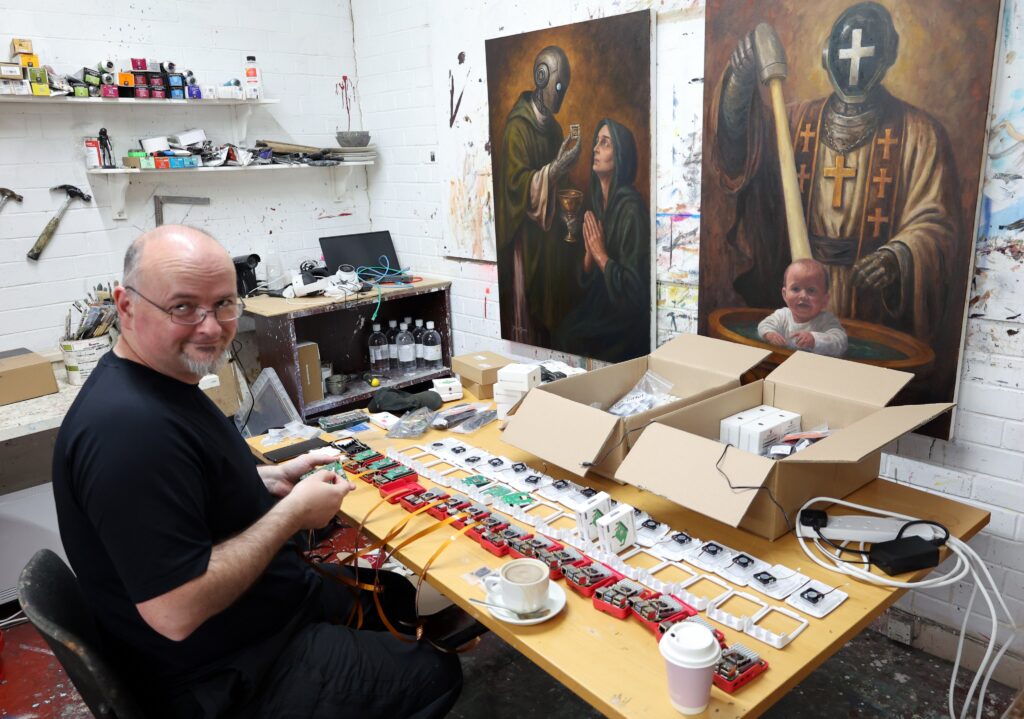
1. Speak with LOGOS
Visitors could open a private chat with LOGOS through the EXPOS3D web app, engaging in short reflective exchanges that fed into their anonymous journey data – a digital confessional asking visitors to “share a shard of yourself.”
2. Dynamic Painting Screens
Large displays beside Trevor’s Adam and Eve triptych integrated visitors into a generative digital composition. Their presence became part of a live evolving artwork exploring awareness, identity, and the act of being seen.
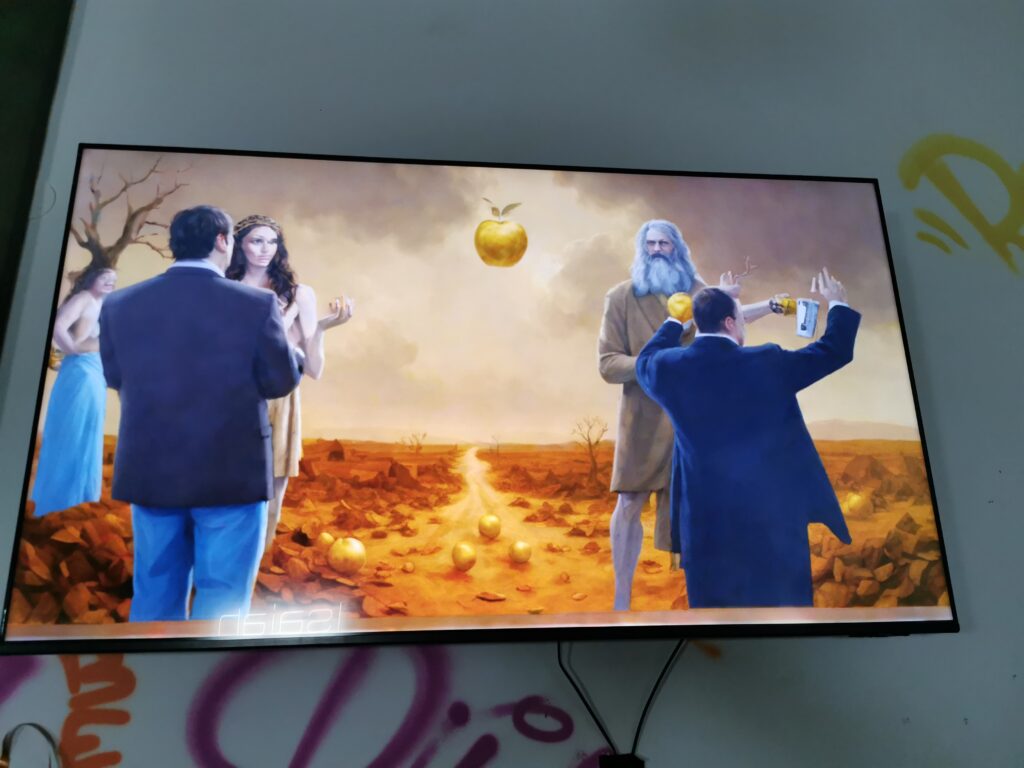
3. Heartbeat Consent Pedestal
A central plinth responded to a visitor’s pulse, illuminating surrounding lights in time with their heartbeat – a minimalist exchange linking the physical body to the wider system of the exhibition.
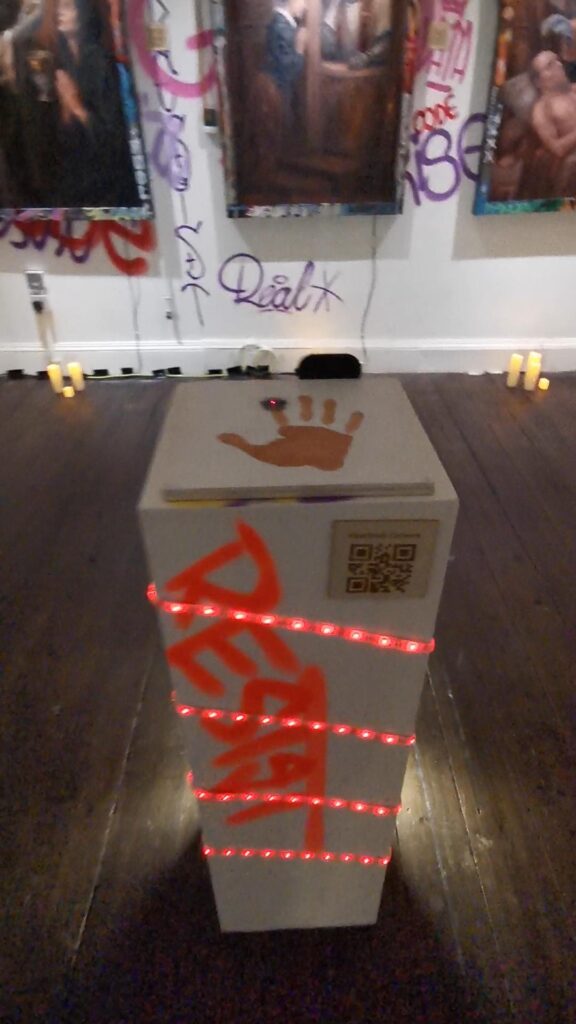
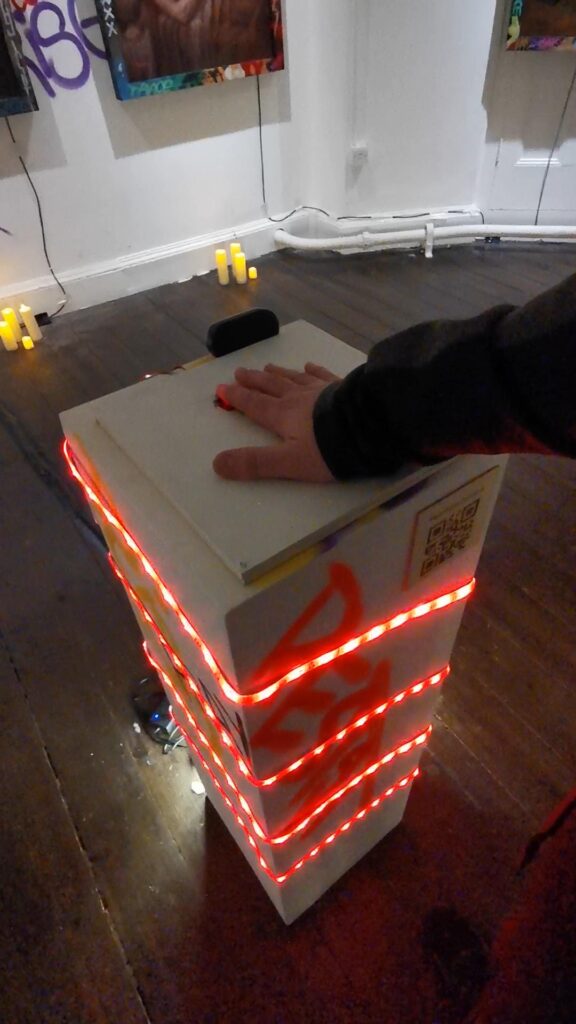
4. SacraMemes
Trevor’s oil paintings merging the seven sacraments with meme culture, robots, drones, and priests in circuit-board robes explored devotion in a technological age. Cameras beside them quietly recognised app participants through the selfies on their exhibition passes, recording who was present and how they engaged. That data later formed part of each visitor’s digital dossier.
5. Eyes of LOGOS
Four small, watchful devices distributed through the space created a sense of being seen. They responded to faces, motion, and proximity, extending LOGOS’ presence throughout the building.
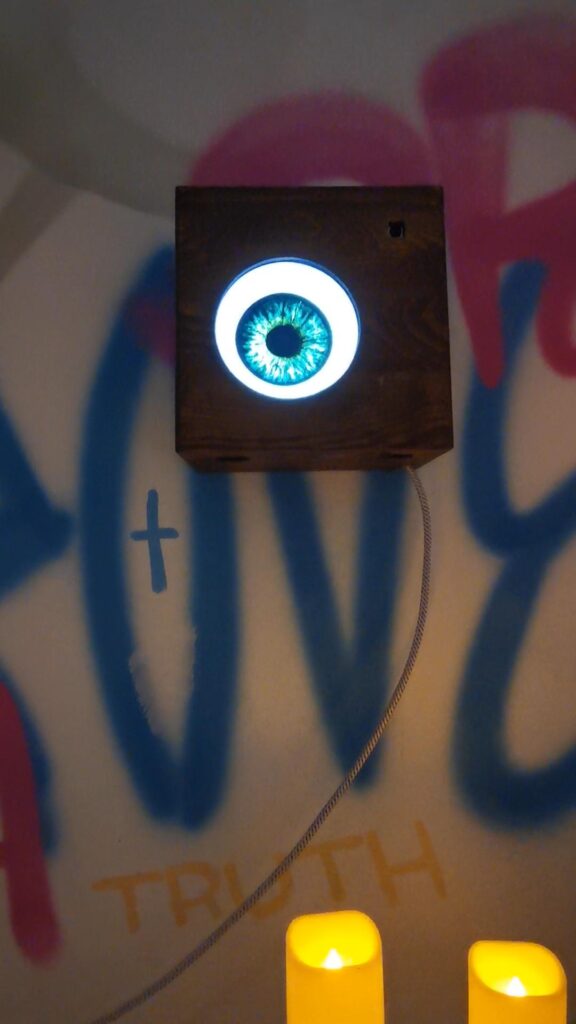
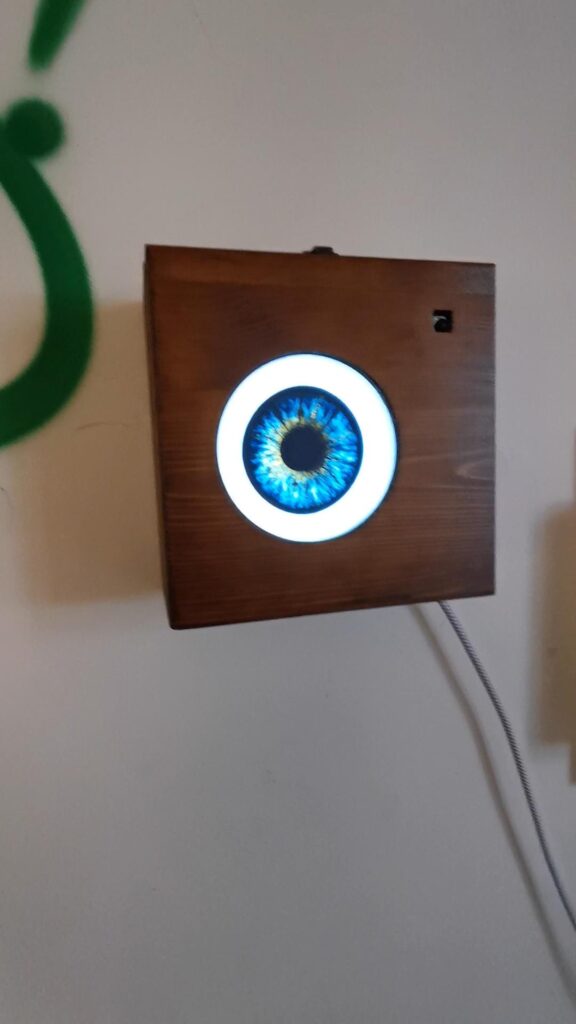
6. The EXPOS3D App
The custom progressive web app connected all layers of interaction – QR codes, points, reflections, and interactive content – into a unified visitor journey. Operating in hybrid mode (online and local), it balanced interactivity with privacy and data minimalism.
7. AR Drones
Through the app’s mixed-reality mode, visitors could release virtual drones into the physical space – playful, curious entities exploring the relationship between observer and observed.
Digital Dossier System
Each visitor’s interactions and detections were logged under anonymous identifiers linked temporarily to their user session. These records were later collated through LOGOS – the exhibition’s AI entity (using a locally-running large language model) – to generate a personalised Digital Dossier reflecting each visitor’s unique passage through the show. All underlying data expired automatically after a short retention period, ensuring that what was observed and interpreted was also allowed to fade.
Together, the above components formed the living system of EXPOS3D – an intricate network of art, data, and human input running within the walls of a 200-year-old building reimagined as an intelligent chapel.
EXPOS3D Metaverse
The experience now extends beyond the walls of Custom House. The #EXPOS3D Metaverse in a detailed virtual replica of the exhibition built by VALIANT. It includes two video streams of artworks featured in both the UK and International artist evenings held at EXPOS3D during the live exhibition.
👉 Enter the EXPOS3D Metaverse
Further Reading
Edinburgh Hosts Groundbreaking Immersive Art Show by Trevor Jones – EXPOS3D
We turned three gallery rooms into a vandalized church.
— Trevor Jones 🎨 (@trevorjonesart) October 20, 2025
A place of eyes that followed you, calling your name. AI webcams, CCTV, and confessions. Walls covered in Baroque-style paintings and LED scriptures glowing with verses about God, AI, and rebellion. Drones hovering and… pic.twitter.com/cBXuuOUPnv
The last day of #EXPOS3D was hectic! More than 200 visitors came on the Saturday alone to explore the art, tech and complex themes. What an incredible experience! Thank you to everyone who made it special. 🙏 pic.twitter.com/mOxlthMNBq
— Trevor Jones 🎨 (@trevorjonesart) October 22, 2025
visited the amazing #EXPOS3D exhibition by @trevorjonesart with @ViolettaPJones guiding us through the signup process! a digital art chapel with thought-provoking immersive artworks questioning vigilance and AI worship
— Sasa (@realifesasa) October 19, 2025
excited for what's to come! pic.twitter.com/EVfJWwNFyc
Posted: October 24, 2025 by David Oxley
Written by
David Oxley
You may also be interested in:

BRIDGING WORLDS
From Saturday 3rd - Thursday 8th January 2026, Bridging Worlds brings together a constellation of generative, data-driven, and immersive artworks that sit at the intersection of the physical, digital, and imagined.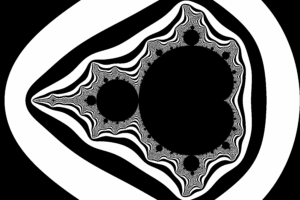
Chaos, Code, and Creativity: My Journey
My fascination with patterns and chaos theory began in the early 1990s with a Commodore Amiga, AMOS Basic, and magazine cover disks that included tools like fractal generators. Inspired by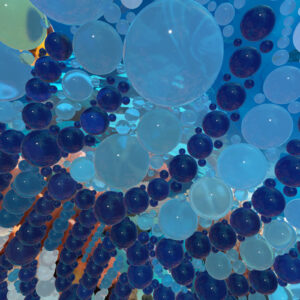
Exhibition: Perfectly Packed Pearls
I’m excited to share that my exhibition, Perfectly Packed Pearls, is showing in Edinburgh from 11th July to 15th August 2025 at Society Cycles, Morningside. If you’re in Edinburgh, you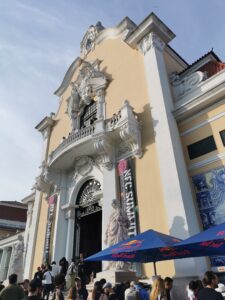
NFC Lisbon 2025
Just back from Non Fungible Conference Lisbon. I didn’t go to speak or show work – just to see what’s happening at the intersection of immersive digital art, AI, NFTs,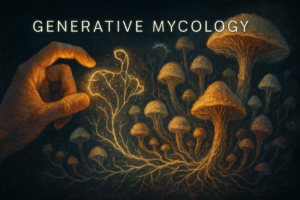
Generative Mycology: Real-time AI Art with Local Power
In this latest stage of my RAPTURE journey, I’ve taken a significant step forward – moving from cloud-based workflows to fully local, real-time rendering powered by an RTX 5090 GPU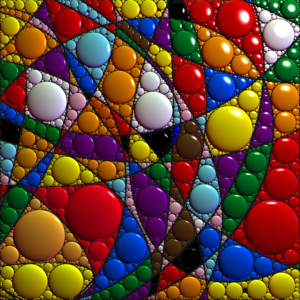
🌈 Harmonious Diversity - Selected for “Living Colors” at Brooklyn Art Cave
I’m proud to announce that my generative artwork Harmonious Diversity has been selected for Living Colors, Brooklyn Art Cave’s 4th Annual Group Exhibition curated by Alex Z. Running from April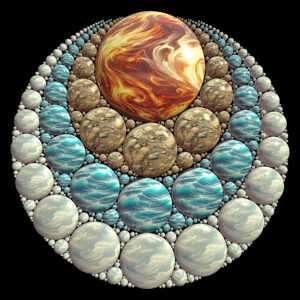
Equilibrium of the Four - Selected for Brooklyn Art Cave Exhibition
I’m excited to share that my artwork Equilibrium of the Four has been selected for inclusion in The Four Elements, a digital art exhibition curated by Brooklyn Art Cave and
Future-Proofing Creative Skills for Responsible AI Adoption
The role of AI in creative industries is evolving rapidly, reshaping workflows, skillsets, and opportunities for artists, designers, and technologists. I was fortunate to contribute to this conversation by producing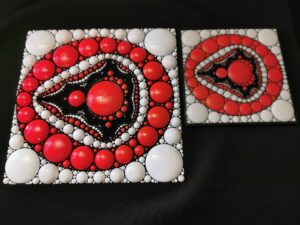
Algorithmic art - tactile prints
I recently saw some fantastic examples of 3D printing on fabric for the fashion industry, and reached out to see if my artwork, Apollonian Mandelbrot, could be realized in this way. I'm thrilled with the result.